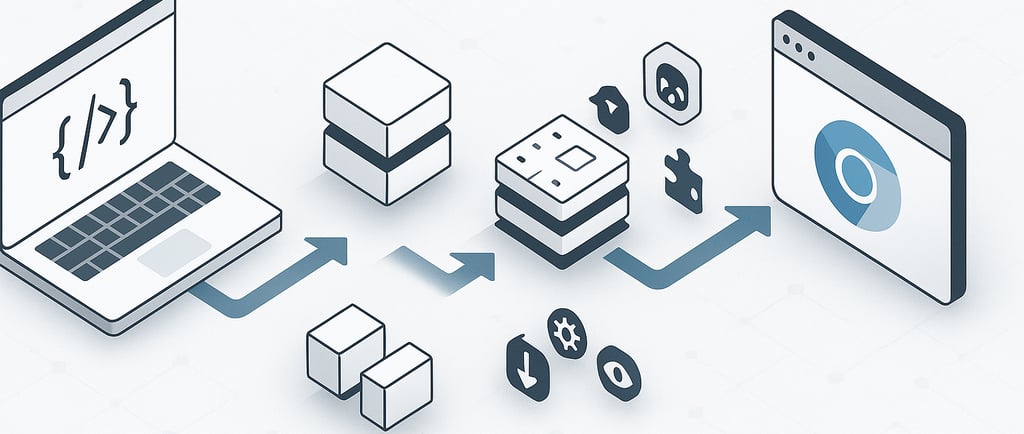ChromeOptions in Selenium (Java)
A practical guide to ChromeOptions for Selenium Java. Learn the top 10 configurations used in real projects - headless, downloads, proxy, mobile emulation - along with risks, clean code snippets, and interview questions with answers.
SELENIUM
8/13/20253 min read


What is ChromeOptions?
ChromeOptions configures Chrome before launch: headless mode, flags, profiles, proxy, downloads, emulation, logging, certificates, extensions, and more. In Java, you pass it to new ChromeDriver(options) or RemoteWebDriver.
Why should you care?
Stable CI: predictable flags and headless runs.
Reproducibility: same behaviour locally and in pipelines.
Speed & reliability: tune page load strategy, memory use, and downloads.
Coverage: emulate devices/locales, inject extensions, test through proxies.
Security workflows: allow/deny certs and permissions for negative tests.
Top 10 real-world recipes:
Headless CI with stability flags (Linux/Docker)
import org.openqa.selenium.chrome.ChromeDriver;
import org.openqa.selenium.chrome.ChromeOptions;
ChromeOptions options = new ChromeOptions();
options.setHeadless(true);
options.addArguments("--no-sandbox", "--disable-dev-shm-usage");
ChromeDriver driver = new ChromeDriver(options);
Deterministic downloads (no prompts, custom folder)
import java.nio.file.Path;
import java.util.Map;
ChromeOptions options = new ChromeOptions();
Path dir = Path.of(System.getProperty("user.home"), "downloads-sel");
options.setExperimentalOption("prefs", Map.of(
"download.default_directory", dir.toAbsolutePath().toString(),
"download.prompt_for_download", false,
"profile.default_content_setting_values.automatic_downloads", 1
));
Block popups & notifications
ChromeOptions options = new ChromeOptions();
options.addArguments("--disable-notifications", "--disable-popup-blocking");
Mobile device emulation (quick responsive checks)
import java.util.Map;
ChromeOptions options = new ChromeOptions();
options.setExperimentalOption("mobileEmulation", Map.of("deviceName", "Pixel 7"));
// Or custom metrics:
// options.setExperimentalOption("mobileEmulation", Map.of(
// "deviceMetrics", Map.of("width", 390, "height", 844, "pixelRatio", 3),
// "userAgent", "Mozilla/5.0 ... Mobile Safari/537.36"));
Clean, isolated profile (avoid state leaks)
import java.nio.file.Files;
ChromeOptions options = new ChromeOptions();
options.addArguments("--incognito"); // simplest isolation
// Or a temp user data dir for deeper isolation:
options.addArguments("--user-data-dir=" + Files.createTempDirectory("chrome-prof"));
Proxy (HTTP/HTTPS) via Selenium’s Proxy
import org.openqa.selenium.Proxy;
Proxy proxy = new Proxy();
proxy.setHttpProxy("corp-proxy.local:3128");
proxy.setSslProxy("corp-proxy.local:3128");
ChromeOptions options = new ChromeOptions();
options.setProxy(proxy);
Accept insecure certs (for negative-path or test envs)
ChromeOptions options = new ChromeOptions();
options.setAcceptInsecureCerts(true);
Add an extension (audit tools, recorders)
import java.nio.file.Path;
ChromeOptions options = new ChromeOptions();
options.addExtensions(Path.of("path/to/extension.crx").toFile());
Faster navigations with PageLoadStrategy (use with care)
import org.openqa.selenium.PageLoadStrategy;
ChromeOptions options = new ChromeOptions();
options.setPageLoadStrategy(PageLoadStrategy.EAGER); // stops at DOMContentLoaded
RemoteWebDriver / Grid usage
import org.openqa.selenium.remote.RemoteWebDriver;
import java.net.URL;
ChromeOptions options = new ChromeOptions().setHeadless(true);
RemoteWebDriver driver = new RemoteWebDriver(new URL("http://localhost:4444"), options);
Interview questions with answers (ChromeOptions, Java)
What problems does ChromeOptions solve over a plain ChromeDriver()?
Answer: It configures Chrome pre-launch for reproducible, stable tests: headless, memory flags, downloads, proxies, extensions, emulation, certs, and logging—so runs are consistent across dev laptops and CI.Headless vs headed: when to use each, and parity issues?
Answer: Use headless for CI speed/stability; headed to mimic user rendering and debug visuals. Parity issues: font/render differences, scroll/viewport behavior, focus/hover timing. Keep at least one headed smoke suite.How do you set a custom download folder locally and on Grid?
Answer: Set Chrome prefs via options.setExperimentalOption("prefs", Map.of("download.default_directory", absPath, "download.prompt_for_download", false)). On Grid the folder is on the node, so fetch artifacts from the node (volume mount, S3, or Grid’s artifact feature if available).Explain PageLoadStrategy.NORMAL vs EAGER vs NONE. When does EAGER help?
Answer: NORMAL: waits for full load; EAGER: returns after DOMContentLoaded; NONE: returns immediately after initial response. EAGER speeds content-heavy sites where late ads/images aren’t needed for your checks—risk: you can miss late errors/resources.How do you configure mobile emulation for a known device vs custom metrics?
Answer: Known device:
options.setExperimentalOption("mobileEmulation", Map.of("deviceName", "Pixel 7"));
Custom:
options.setExperimentalOption("mobileEmulation", Map.of("deviceMetrics", Map.of("width",390,"height",844,"pixelRatio",3),
"userAgent","Mozilla/5.0 ... Mobile Safari/537.36"));
What does --disable-dev-shm-usage do and why in Docker CI?
Answer: It tells Chrome not to rely on /dev/shm (shared memory). Small containers have tiny /dev/shm, causing renderer crashes; this flag reduces those crashes.How do you load a Chrome extension and what are CI trade-offs?
Answer:
options.addExtensions(Path.of("path/to/extension.crx").toFile());
Trade-offs: version drift, extra startup time, and potential network calls. Pin CRX versions and cache them in CI.How do you set a proxy in Java and what about auth/PAC?
Answer:
Proxy p = new Proxy();p.setHttpProxy("host:3128"); p.setSslProxy("host:3128");
options.setProxy(p);
Auth proxies may need browser-level credentials, system keychain, or running tests with a proxy that allows IP whitelisting. PAC files require system config or additional flags.How do you capture console/performance logs and assert on them?
Answer: Enable logging prefs and then read logs:
import java.util.logging.Level;import org.openqa.selenium.logging.LogType;
import org.openqa.selenium.logging.LoggingPreferences;
LoggingPreferences lp = new LoggingPreferences();
lp.enable(LogType.BROWSER, Level.ALL);
lp.enable(LogType.PERFORMANCE, Level.ALL);
options.setCapability("goog:loggingPrefs", lp);
// Later:
// var entries = driver.manage().logs().get(LogType.BROWSER);
// assertTrue(entries.getAll().stream().noneMatch(e -> e.getMessage().contains("SEVERE")));
Why is reusing your personal Chrome profile risky, and what’s safer?
Answer: It leaks cookies/storage, plugins, and flags into tests, causing flakiness and security issues. Prefer --incognito or a temp --user-data-dir per run; clean it up after.